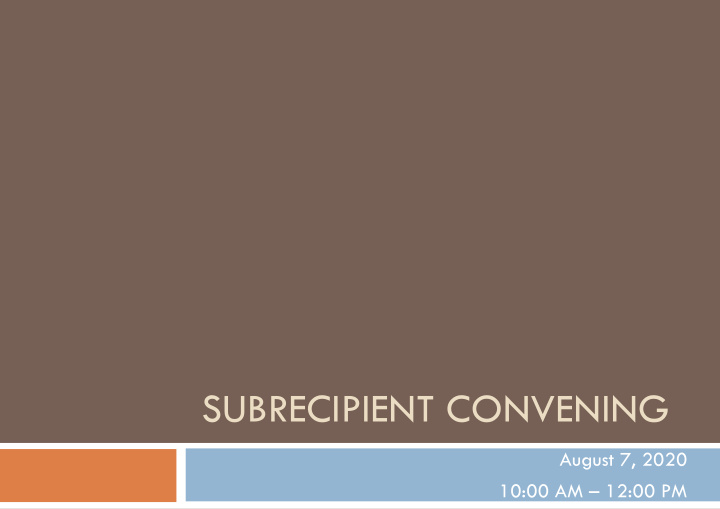



SUBRECIPIENT CONVENING August 7, 2020 10:00 AM – 12:00 PM
Agenda Welcome I. Virtual Convening Notes A. GIW is out! B. First week of Fiscal and Program & Grants Cohorts C. 2019 CoC Application Score Debrief II. Data: What is it good for? III. Closing Thoughts IV.
Virtual Convening Notes Facilitators will adapt schedule as needed 1. Please MUTE yourself when not speaking 2. (Facilitator’s will mute you otherwise) Use the “Raise Hand” and “Chat” functions to add 3. comments or questions Please defer judgment, stay on-topic, and build upon 4. others’ ideas No use of other technology (if possible) 5.
GIW is out! ¨ What is it? ¨ Where is it? https://www.hudexchange.info/programs/coc/coc-giw- reports/ ¨ Review it ¨ Look out for contact from HSH…
Community of Practice: Launch of Cohorts
2019 CoC Application Score Debrief A Few Terms: ¨ The Collaborative Applicant (HSH) is the eligible applicant designated by the CoC to submit the CoC Consolidated Application, which includes the: ¤ CoC Application, ¤ CoC Priority Listing, and ¤ Individual Project Applications. ¨ The CoC Application contains an array of narrative questions about systems and subpopulations, as well as data requirements and performance measures.
2019 CoC Application Score Debrief ¨ In early 2020, HUD announced SF was awarded $47,849,533 in the 2019 CoC Competition ¤ 60 total projects and 1 planning grant ¨ This was an increase of $3,312,013 ¤ 107% of San Francisco’s 2018 funding ¨ The increase is from: ¤ New DV bonus project ¤ Annual increases in FMRs ¤ Addition of YHDP Projects to CoC Program ¨ CoC awards and annual renewal demands directly correlate to how the CoC scores on the CoC Application
2019 CoC Application Score Debrief ¨ In May, HUD sent each CoC its overall application score and a debriefing document with information about selected scoring factors. ¨ In 2019, San Francisco scored 168.5 points out of 200, which represents a 4-point increase over last year’s score.
2019 CoC Application Score Debrief
2019 CoC Application Score Debrief Breakdown of Scoring Summary ¨ High Priority CoC Application Questions ¨ CoC Scoring Summary
High Priority CoC Application Questions ¨ HUD provided 13 specific scores related to questions it designated as High Priority, covering: ¤ Project Review, Ranking, and Selection; ¤ HMIS Bed Coverage; ¤ System Performance; ¤ Performance and Strategic Planning Objectives; and ¤ Accessing Mainstream Benefits & Additional Policies. ¨ The High Priority questions constitute 106 out of the 200-point total.
High Priority CoC Application Questions San Francisco received the maximum points available on 9 of the 13 High Priority Questions, equaling 88 points. Objective Project Ranking & Selection 1. Considers Severity of Needs & Vulnerabilities 2. Reduced Average Length of Time Homeless 3. Successful Permanent Housing Placement & Retention 4. Job & Income Growth 5. Timely SPM Data Submission 6. Lowering Barriers to Entry 7. Street Outreach Efforts 8. Increase in RRH Beds 9.
High Priority CoC Application Questions ¨ SF lost 8 points (out of 106) on the remaining 4 High Priority Questions because of: ¤ Lack of complete HMIS bed coverage ¤ Increase in first time homeless ¤ Returns to homelessness rate 6 months after exit from PH ¤ Not rehousing households with children within 30 days
CoC Scoring Summary ¨ HUD also provided the total scores for 6 overarching categories ¤ The High Priority Questions fall within these ¨ SF received 168.5 out of the 200 total available points ¨ The biggest places for improvement relate to our local data ¤ As mentioned, the score is based on narratives about our system and our data ¨ One of the sources of the data is individual project APRs, which is aggregated to measure System Performance ¨ Your APRs are also used to generate your project scores on objective measures in the local CoC competition
System Performance Measures
Data: What is it good for? ¨ We know that our data has a direct impact on our national SF CoC score and our individual project scores ¨ We know that this data is how HUD sees us…how others see us..
Data: What is it good for? ¨ We also know that these measures cannot possibly capture the ways in which you impact clients on a day- to-day basis or what you overcome to provide services ¨ But given we must collect this data, how can we use it to run our programs better, improve services our clients, build networks and best practices throughout the community?
Discussion ¨ Do you regularly use data to help you do your job, serve program participants, meet objectives? ¤ What services do you track? ¤ What type of objectives? ¨ Where do you get that data (e.g., ONE, Salesforce)?
Discussion What would you change in your program if you knew: ¨ Clients who exited your program were returning to the system again? ¨ Households with children waited more than 3 months to get into your program’s housing? ¨ Adults were increasing their income while in your program? ¨ The average length of time households required RRH assistance was 18 months? 24 months? Longer?
Data: What is it good for? ¨ What would you be interested in learning more about? ¤ Trying to improve? ¨ If we started a working group to look at data and performance, would you attend? ¤ Should it be time limited to achieve discreet goals? ¤ Should it be ongoing to continually improve quality?
Closing Thoughts…Questions? sf@homebaseccc.org
Recommend
More recommend